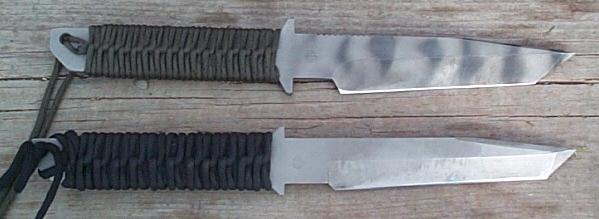
Originally this knife review was of a Strider WB owned by Brian Thornburg. As the knife and sheath have seen alterations in design a newer one was provider by Strider. The review now contains information on both models as well as several other blades used as points of reference.
Both WB's are made from 1/4" ATS-34 heat treated by Paul Bos to 60-61 RC. The new one weighs 306 g and the older one 293 g. The new one has a primary edge length of 10.8 centimeters with the Tanto edge length being 3.0 centimeters. The old WB has a primary edge length of 11.2 centimeters and a Tanto edge length of 2.8 centimeters. However the guards on the new WB are slightly wider 4.4 centimeters as opposed to 3.5 cm on the old one. The new cord is also slimmer, 2.7 mm wide as opposed to 3.7 mm for the old version. This smaller cord enhances the difference in guard width.
| Version | Weight | Primary edge | Tanto | Guard height | cord thickness |
|---|---|---|---|---|---|
| grams | cm | ||||
| New | 306 | 10.8 | 3.0 | 4.4 | 0.27 |
| Old | 293 | 11.2 | 2.8 | 3.5 | 0.37 |
In regards to the primary and secondary grinds; the new WB (at the broadest point) is 3.4 centimeters wide and has a 1.72 centimeter wide hollow grind on one side, 1.65 centimeters high on the other. The older WB is only 2.8 centimeters in width and the hollow grind only 1.55 centimeters wide on one side and 1.40 centimeters high on the other. Back five millimeters from the edge the new WB is 0.066" thick, the older one is 0.078" thick, so the new WB has a significantly deeper grind. The edge on the new WB is also significantly more acute. The blade at the back of the edge bevel is 0.025" thick and the edge is about .035" wide, this is a bevel angle of about 20 +/- 2 degrees which agrees with the description of the edge according to Mick Strider :
The bevel is ground on an eight inch contact wheel to a height of .625. We leave a dead space of .020 before sharpening and sharpen at an angle of 22.5 degrees.
The edge bevel on the older WB is uneven. The blade thickness at the back of the bevel is about .035", so it is slightly thicker than the new WB, but the edge angle grinds are much more obtuse. On one side it is about 35 +/- 2 degrees and on the other about 27 +/- 2 degrees.
The tip on the new WB is much more obtuse than on the older model. On the new WB the blade goes from 6.5 mm thick to the point in 8 mm (that is about a 22 degree grind). On the older WB the tip grind starts at 6mm thick and reaches the point in 1.2 centimeters (that is about a 14 degree grind).
| Version | Width | Grind | Edge | Point | ||
|---|---|---|---|---|---|---|
| height | thickness | angle | thickness | angle | ||
| cm | inches | degrees | cm | degrees | ||
| New | 3.4 | 1.65-1.72 | 0.025 | 18-22 | 0.65 | 22 |
| Old | 2.8 | 1.40-1.55 | 0.035 | 27-35 | 0.60 | 14 |
A side shot, new WB is on top :

The tips, new WB is to the left :
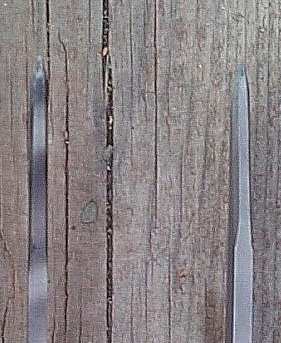
The sheaths, new sheath is on bottom :
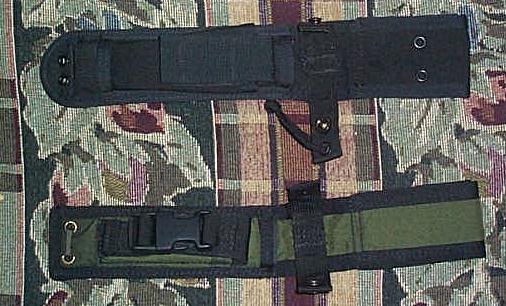
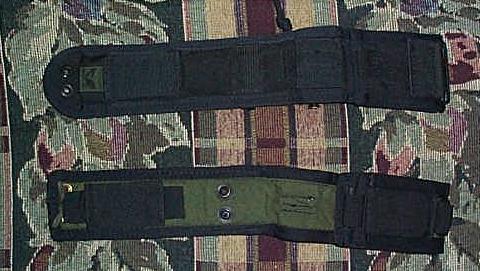
The standard grind used to be sabre hollow but was recently changed to full flat. Composite handles are also an option instead of the cord wrap.
The grind differences between the WB's gives them distinctly different cutting and chopping abilities. The new WB easily out cuts and out chops the older version. Used for chopping and whittling woods as well as slicing some cord the performance difference was immediately obvious. As well, during felling and limbing out a few small saplings (lane clearing) the new WB consistently outperformed the old. Of course the tradeoff of the deeper hollow grind and more acute edge bevel is durability.
Interestingly, the relative point profiles are reversed with the new one being significantly more obtuse. The old WB can easily be stabbed one inch into wood, the new one if difficult to get more than half an inch. This makes a large difference in prying/digging work, the old WB easily digs a hold in a piece of wood with far greater speed than the new version. Again, durability is with the more obtuse tip.
As for the handle, the smaller diameter cord raises ergonomics by increasing the number of contact points. The smaller cord also makes the guards more pronounced. Both sheaths are made from a combination of Cordura and Kydex by Special Operations Equipment and are very well done, very rigged design.
The relatively thick stock of the WB and shallow sabre grind do hinder cutting ability and put it significantly behind a knife like the A. G. Russell Deerhunter for work such as food preparation, cord, thick layered webbing, and carving wood. On really deep cuts the WB's wedge at the top of the hollow grind. A slimmer blade requires much less force, up to five times on really thick rope for example. As an example, a dozen stakes were pointed (no resting during a point) with a few blades :
| Model | Number of slices | Performance Ratio | Rank |
|---|---|---|---|
| Deerhunter | 10 +/- 1 | 1 | 100 |
| Battle Mistress | 15 +/- 1 | 1.5 +/- 0.1 | 69 +/- 5 |
| Project I | 19 +/- 1 | 1.8 +/- 0.1 | 55 +/- 4 |
| WB (new) | 30 +/- 2 | 2.9 +/- 0.3 | 34 +/- 3 |
| WB (old) | 47 +/- 2 | 4.5 +/- 0.4 | 22 +/- 2 |
The performance is dependent on the size and nature of wood. To illustrate a piece of hardwood was cut, and a smaller piece of pine :
| Model | 3/4"x1.5" pine | 1/4"x1" hardwood | 3/4"x3/4" pine |
|---|---|---|---|
| WB (new) | 34 +/- 3 | 43 +/- 3 | 61 +/- 6 |
| WB (old) | 22 +/- 2 | 26 +/- 2 | 41 +/- 4 |
On the harder wood there is less of the blade "seen" by the wood so the thicker blade stock is less of a drawback. On the smaller wood fatigue is less which raises the relative performance ( lower cutting blades fatigue at faster rates [ref].
On materials which do not exert a lot of force on the sides of the blade, such as webbing, the difference in cutting ability is much lower. As with all performance issues, there are tradeoffs. The Deerhunter gives up a lot of strength and durability to obtain its cutting ability, so it cannot be used for tasks such prying. The WB is also heavier so is more powerful on a swing.
While the WB is fairly heavy with a blade forward balance, the chopping ability is reduced due to the same aspects of its geometry which lower cutting ability in general, the very thick primary and edge grinds. The WB's only have about 32 (32) and 38 (2) % of the chopping ability of the Bruks Wildlife hatchet. A similar sized flat ground blade with a more efficient edge profile like the CU/7 can have almost 50% greater performance : ref.
The WB's have fairly abrupt tips which makes them exceptionally strong, though deep penetration is difficult. On heavy stabs into a phone book the new WB only got 296 +/- 13 pages. Even though the gross penetration isn't as high as on some of the larger blades, for some work the WB is still more efficient. Digging holes in wood the WB was a better choice than the Project I mainly as it is more accurate on stabs, and the stronger point allows more force to be used when prying out wood chunks.
For heavy digging, the tip point on the WB's excel. Using Steel Eagle from TOPS, the tip broke off while trying to pry out a piece of seasoned piece of 2x8 plank after a 2.0 cm stab. The Busse Basic could take the same stab depth and prying without breaking but was unable to clear out the wood as it flexed too readily (did not take a permanent set). The older WB could readily pop out the wood with no flex visible it is very strong and can easily hold the bodyweight of an average man (180 lbs). The new WB has a much more obtuse tip and thus cannot dig in wood as readily as the old one.
The handle is cord wrapped around a full tang. The wrap has an interlacing series of loops which creates ridges running down the middle of both sides of the grip. During most cutting work including chopping the the handle was both secure and comfortable, no reddening let alone any blistering after extended use.
Full force stabs into hard woods were also possible with no slips however this started to become uncomfortable quickly. It was not as uncomfortable however as similar work done with the Steel Eagle from TOPS as the steel bumps on the TOPS grip are obviously a lot more abrasive than cord ones on the WB. The thinner cord on the newer WB makes it more ergonomic, many smaller contact points even out the contact pressures, it also shows no significantly loss of security.
In less than ideal conditions the cord wrap stayed very secure in hand, water has no effect, soap and water, chicken and beef fat on the grip still did not prevent high force cuts, chops or stabs.
As the cord completely encloses the tang insulates against temperature extremes, it is still comfortable in hand from -5 -to -10 C. Even after being in a basement freezer it was still usable, unlike knives like the Project and Battle Mistress both of which have exposed metal grips and thus will damage skin on contact when very cold.
To check for durability, the knife was dropped 24 times from 15 feet into rocky ground without cutting through the cord. The handle was also struck with a 600 g mild steel bar, hard elbow swing (64 +/- 9 in.lbs). This mashed the cord but still did not break the outer wrap. Even when the outer wrap it cut, it can be repaired by heat sealing/bonding. There is also an independent internal flat wrap :
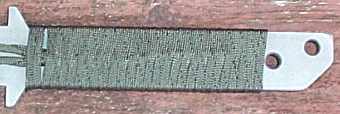
The bare tang :

Working with flat wrap, it is no where near as secure as the outer wrap, nor as comfortable due to the squarish shape. However it does again completely enclose the tang. With all cord removed the tang provides a very insecure and uncomfortable grip. The guards should prevent the hand from ramping onto the blade, but high energy stabs make for some very hard impacts off of the guards. It took eleven and a half feet of paracord to make the outer wrap and five and a half for the inner flat wrap.
Overall the grip is decently comfortable, very secure and decently durable. However there is a significant drawback in that it is very difficult to clean and it has many nooks where dirt can pile up and the cord will also absorb unpleasant substances. Trying to scrub the handle clean is much more difficult than with a regular handle, however it can be boiled to remove any biological problem, and can always be rewrapped if necessary.
During some wood chopping a few accidental chops into a screw knocked several pieces out of the edge of the new WB. The chips were about 0.1 to 0.3 mm deep and about 1 to 2 mm long. There was some steel folded over but some had broken away as well. Repeating with the old WB induced similar damage. Using the spines of the WB's on each other the damage was reduced about 25 to 50 % .
Using the butt of the WB as a hammer a concrete block was easily broken into pieces. Only one to three hits were usually necessary :
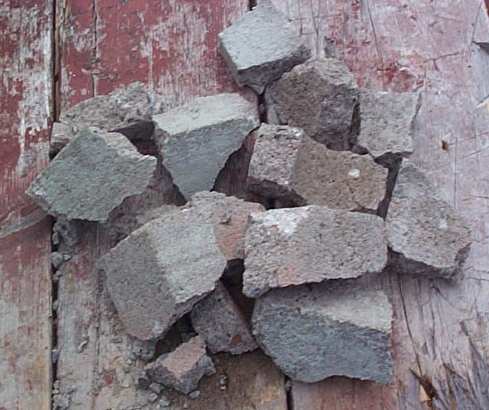
The WB (new) was then used to chop into a concrete block, twenty five light elbow chops basically blunted the edge, minor chipping 0.005-0.010" deep. After twenty five chop from the shoulder the damage was much more extensive. Now the entire bevel was lost in several places, damage of about 0.035" in depth. The blade also suffered fractures of the primary grind :

The large notch is about 0.140" deep and 0.425" long. There are a couple of smaller notches where the fractures are about about 0.05" deep and 0.10" long. For reference the chopping was repeated with a bowie from Ray Kirk.
The bowie fared much better, less edge damage and no propagation into the primary grind even though it is a longer and heavier knife and thus more powerful on the swing. The forged bowie is made from an inherently tougher and more ductile steel which is also softer ~56 HRC to enhance those properties. Note however under light impacts the edge on the bowie took more damage as it was more easily dented.
In regards to the damage to the primary grind, this is an inherent drawback to hollow grinds. Since the hollow grind offers little support if the edge durability is exceeded the damage can propogate into the primary bevel. Flat and convex grinds will limit the damage to the edge to a much greater degree. Hollow grinds also have low resistance to lateral impacts because the weakest part of the profile (the edge) can takes the majority of the impact energy, convex profiles have the opposite behavior.
The chopping was repeated (50 chops) on sections of blade above and below the damaged area. This failed to produce damage beyond the depth of the edge bevel. The damage was higher in the region near the handle. Switching to the middle of the blade, runs of ten chops significantly enlarged the fractured section of the primary grind and the edge soon had a piece missing about 2.5 cm long and about 5.5 mm deep.
The difference in damage is most likely due to that region being the most powerful chopping point. This agreed with the fact that the chopping done with that section of blade took out larger chunks of concrete. The energies were so severe that pieces of concrete along the sides of the cuts were fracturing away. Some shots (the notch on the bottom had the additional 20 chops work ) :
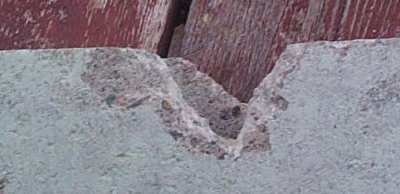
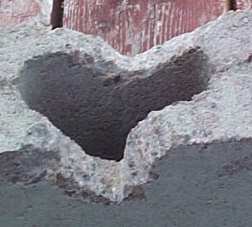
Twenty five full power stabs into the top of the concrete block with the tip of the WB. These made a hole about 1/4" or so deep and did only minor damage to the top of the WB.
In regards to strength, because of the steel (high carbon, high alloy stainless), high hardness, and thick large cross section, the WB is quite strong. It easily held 200 lbs on the handle without excessive flex and took an applied load of about 290 +/- 10 lbs to break the tip. With the force applied about 10" from the point at which the blade was in the angled join, and assuming the force was perpendicular to the handle ( the blade was wrapped to protect against shards), this gives a break torque of 2750 +/- 250 in.lbs. This is high [ref].
After the prying :

Note that the break is not clean and there are several pieces missing. That is common behavior among high carbon, high alloy steels especially stainless ones.
As an extreme application, four sections were cut off of a windshield, using a 600 g steel bar as a mallet to drive the WB through the glass, this was used to promote the Strider knives on Bladeforums : ref. The sections took on average 35 +/- 2 hits to remove a strip. The glass doesn't actually get cut by blade but just breaks apart and is propelled quite some distance from the energy of the hits. The impact slightly increased the damage, however the entire edge has pretty much been removed from the earlier concrete/rock. The glass :
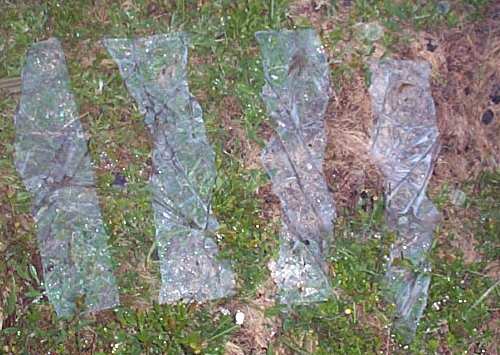
If this actually needed to be done, it is less stressful on the knife to beat a line with the bar (or back of the knife) and then cut through the liner thus avoiding any high energy impacts off of the glass. The tip of the WB can also be used as it is much more robust than the edge and will thus take less damage, however it is much slower.
As a side note, the WB was used to chisel out a piece of a very cheap knife using the steel bar as a mallet (two cuts were made at ~25 degrees which intersected to remove a wedge). The roles of the knives were reversed however the cheap knife was unable to cut into the WB it was simply too hard. The other knife was then chopped on the concrete block (assisted by the 600 g bar), and after twenty five chops was seriously damaged :

The first notch (from the handle) was where the WB was pounded into the cheap knife, the second one was where they were reversed. Note the cuts into the spine, these were also done by the WB. The WB suffered no further significant edge damage during the work. If it had been done before, the damage would likely have been constrained to the edge bevel. This cheap knife is probably around 45 RC, based on specs I have seen listed for similar blades (AISI 420J2) .
The retention of the Velcro belt loop was solid, at 50 lbs it held firm, at 75 lbs it gave slightly, at 100 lbs it parted about 1/3 of the way but then held firm for six repeated loads through three feet. Thus enough force to rip the loop free would tend to pull the user very forcefully. One hundred lbs was also then attached to a cord strung through the rigging loops, which again held fine.
The sheath also has Kydex blade liner to prevent the blade penetrating the walls of the sheath. The Kydex liner is itself lined so that draws are silent. There is a pouch that is large enough to fit even a Leatherman Supertool. The belt loop can opened because of the Velcro and thus the knife can be put on and taken off without removing your belt. As for possibilities of attachment, there are rigging loops at the bottom, front and back, one on the back halfway up and a dual one on the top. There is a leg attachment strap and a metal loop on the top. Finally there are two eyelets on the top and bottom of the sheath.
The Kydex liner on the new WB sheath will only allow the blade to be sheathed in one way and holds the blade firmly. It cannot be shook out. The liner in the old WB's sheath will allow the blade to be sheathed with the edge in either direction and does not hold the blade securely. If the sheath is turned upside down the blade will fall out.
In regards to Kydex, such sheaths tend to suffer stress fractures when exposed to low temperatures for an extended period of time [ref] . The sheath for the WB however has not been effected at all by the low temperatures and has taken impacts that have functionally damaged Kydex sheaths. Of course the liner is still Kydex and could be damaged by a high energy impact when cold, however the Cordura will absorb some of the shock and will hold the liner together in case it is cracked. As well the liner is small, and you could easily carry a spare.
One last comment regarding the sheath, comments have been made that Velcro is loud noise and can become nonfunctional when muddy. In the WB sheath the Velcro is only used to allow the entire sheath to be removed, and while it can be contaminated to the degree it becomes nonfunctional, this takes extreme circumstances. Because of the placement of the Velcro on the sheath it is very difficult to get dirt in there.
The grip could be epoxy coated to increase the durability and ease of clean. For this type of knife (pry bar) I would prefer a convex primary grind as it will be stronger and tougher. A tougher steel would also be of benefit, possibly spring tempered along the spine for extreme applications. It would also be interesting to see the same blade in ATS-34 but tempered to a lower hardness to see if the same type and extent of fracture would would have happened on the harder work.
The WB had decent cutting ability for a knife of its class and proved to be capable of handling high prying loads with little or no flex - however in extreme circumstances the knife did break with little to no flex. The corrosion resistance was high, no rust was seen during use. The handle ergonomics were decent and the security very high. The handle however could become difficult to clean in extended use, and is susceptible to damage from abrasion or cuts which can't effect a Micarta grip.
Comments can be sent to : cliffstamp[REMOVE]@cutleryscience.com or by posting in the following thread on Bladeforums :
For further information see : Strider's website.
In the following thread
the Strider guys comment on the above work : reference
thread.
| Last updated : | Tue Sep 9 12:32:26 NDT 2003 |
| Originally written : | 7/27/2001 |